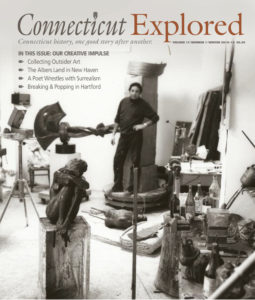 By Elizabeth Normen, Publisher
By Elizabeth Normen, Publisher
(c) Connecticut Explored Inc. Winter 2018-2019
Subscribe/Buy the Issue!
Long before I discovered a love of history—and particularly Connecticut history—I was a student artist who eventually realized that I was not meant to BE an artist. But in my second job I was “artist-adjacent.” I worked as the membership coordinator at the Wadsworth Atheneum, an experience that was formative for me.
This issue’s stories about artists and creators, therefore, resonate with me, especially in their insights into how the individuals came to create the work for which they became known. Some, like Josef Albers, Anni Albers (page 26), and Elbert Weinberg (page 32), seemed destined to become artists—though each faced significant challenges along the way.
Others’ stories feel less inevitable. Poet Wallace Stevens (page 38) was an insurance executive by day, and artist Ellis Ruley (page 20) was a laborer who didn’t become an artist until late in life. And then there’s Orson Fowler (page 44, and, to be exact, not a Connectican), whose claim to fame is being a proponent of the eight-sided house. He sparked an architectural phenomenon that lasted only from about 1850 to the Civil War.
We can’t know whether or not our creative impulses will yield greatness, be rewarded with fame or money, or warrant a mention in the history books. What I appreciate about these stories is what they reveal about the journey and what it takes to be creative, and that being creative is an opportunity open to all of us brave enough to fan our inner creative flame, in whatever field of endeavor we choose (art, poetry, tonight’s dinner), without regard to what may or may not come of it.
In part, our purpose as the magazine of Connecticut history is to explore how Connecticut fostered or impeded that opportunity. My hope would be that we work in the present and future to tip the scales toward fostering, rather than impeding. In that spirit we celebrate Tim Wolf and his brief but inspiring chapter organizing the Peace Train Breaking & Popping Contest (page 14) at an early, key moment for Hip Hop. We tip our hat to all of the organizations in the state that work to foster creativity in our youth, and we urge our readers to support them.
 Support the Friends of Connecticut Explored
Support the Friends of Connecticut Explored
I invite you to support our work at Connecticut Exploredthrough a gift to the Friends of Connecticut Explored. In addition to publishing four issues of the magazine each year, Connecticut Explored is bringing a treasure trove of stories about Connecticut history to the airwaves—in collaboration with State Historian Walter Woodward— and working to ensure that our next generation of kids has a foundational knowledge of Connecticut history through our third/fourth-grade book and website Where I Live: Connecticut and our next project, for fifth to seventh grades, Venture Smith’s Colonial Connecticut. Eighth-graders and high-school civics classes are learning about the state’s governance and constitutional history through the Constitution of 1818 resources created last fall (and available for free on our website). We continue to find this work rewarding, particularly in developing collaborations with teachers and with other organizations that share this goal.
Please help us continue this work with your gift to the Friends of Connecticut Explored. Gifts of $100 or more received by December 31 will be listed in the Spring 2019 issue; please consider $160 for our 16th year!
Explore!
Read all of the stories in the Winter 2018-2019 issue
Read all of our stories about Connecticut’s art history on our TOPICS page
